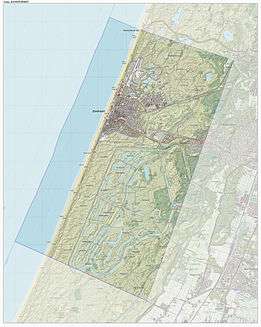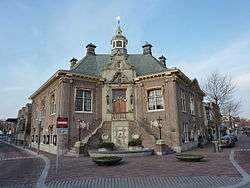Zandvoort
| Zandvoort | |||
|---|---|---|---|
| Municipality | |||
|
Zandvoort city hall | |||
| |||
.svg.png) Location in North Holland | |||
| Coordinates: 52°22′N 4°32′E / 52.367°N 4.533°ECoordinates: 52°22′N 4°32′E / 52.367°N 4.533°E | |||
| Country | Netherlands | ||
| Province | North Holland | ||
| Government[1] | |||
| • Body | Municipal council | ||
| • Mayor | Niek Meijer (VVD) | ||
| Area[2] | |||
| • Total | 43.97 km2 (16.98 sq mi) | ||
| • Land | 32.07 km2 (12.38 sq mi) | ||
| • Water | 11.90 km2 (4.59 sq mi) | ||
| Elevation[3] | 3 m (10 ft) | ||
| Population (May 2014)[4] | |||
| • Total | 16,546 | ||
| • Density | 516/km2 (1,340/sq mi) | ||
| Demonym(s) | Zandvoorter | ||
| Time zone | CET (UTC+1) | ||
| • Summer (DST) | CEST (UTC+2) | ||
| Postcode | 2040–2042, 2116 | ||
| Area code | 023 | ||
| Website |
www | ||

Zandvoort (Dutch pronunciation: [ˈzɑntfoːrt]) is a municipality and a town in the Netherlands, in the province of North Holland.
Zandvoort is one of the major beach resorts of the Netherlands; it has a long sandy beach, bordered by coastal dunes. It is also the site of the country's most important automobile racing circuit, Circuit Park Zandvoort.
There is a nudist beach located about 2 km to the south, with 6 cafés or restaurants; it extends several kilometers further south.
The municipality of Zandvoort consists of the communities of Bentveld and Zandvoort.
History
Zandvoort is known to exist in 1100, called Sandevoerde (a combination of "sand" and "voorde", meaning ford). Until 1722 the area was under the control of the Lords of Brederode.
The village was dependent on fishing for many centuries until the 19th century when it started to transform itself into a seaside resort, following the pattern set by similar towns in the United Kingdom. In 1828 the first resort was inaugurated. Thereafter many notable persons would visit Zandvoort, including Elisabeth of Bavaria in 1884 and 1885. In the middle of the same century, potato cultivation started in the dunes.
In 1881 the railway station near the coast opened, followed by tram connection to Haarlem in 1899, which greatly increased the beach tourism. In 1905 one of the earliest Dutch fictional films was shot in the town, De mésaventure van een Fransch heertje zonder pantalon aan het strand te Zandvoort.
During World War II, Zandvoort was heavily damaged. On May 23, 1942, beach access was no longer permitted and several months later the town was almost completely vacated. Resorts and avenues were demolished to make way for the coastal fortifications of the Atlantic Wall.
After the war, the town's growth accelerated, matching the growth in tourism. In 1948, Circuit Park Zandvoort was built, hosting the Dutch Grand Prix for several decades. Zandvoort continues to be a major Dutch resort location, where nearly half of all employment is related to tourism.
The Dutch singer Willem Duyn's De Eerste Trein Naar Zandvoort ("First train to Zandvoort") - modeled on the American song Chattanooga Choo Choo and chronicling chaos and mayhem on the first seaside train - was a hit in the summer of 1983.
Transport
Zandvoort has a station, with half-hourly services to Haarlem and Amsterdam, with extra services from Haarlem during the summer. The station is Zandvoort aan Zee railway station.
Local government

The municipal council of Zandvoort consists of 17 seats, which are divided as follows since 2010:
- VVD 5 seats
- Ouderen Partij Zandvoort [5] 3 seats
- PvdA 2 seats
- CDA 2 seats
- Gemeente Belangen Zandvoort [6] 2 seats
- GroenLinks 1 seat
- Sociaal Zandvoort [7] 1 seat
- D66 1 seat
Notable residents
- Piet Keur (b. 1960), football player
- Jan Lammers (b. 1956), racing driver (Formula One)
- Roy Schuiten (1950–2006), cyclist and team manager
- The German impressionist and expressionist painter Lovis Corinth died of pneumonia in Zandvoort in 1925, having made a final visit to the Netherlands to see his favourite Dutch masters.
- William Merritt Chase 1884-1885. American Impressionist Painter (1849–1916) Painted one of his masterpieces here entitled "Sunlight and Shadow" which hangs in the Joslyn Art Museum in Omaha, Nebraska.
- On 7 August 2007, a 2.5 m (8 ft) tall Lego figure was found in the sea at Zandvoort. It was fished out and placed on the beach. It is wearing a blue shirt with the slogan "No Real Than You Are" and red trousers. Its origins are unknown.[8]
References
- ↑ "Burgemeester Niek Meijer" [Mayor Niek Meijer] (in Dutch). Gemeente Zandvoort. Retrieved 24 March 2014.
- ↑ "Kerncijfers wijken en buurten" [Key figures for neighbourhoods]. CBS Statline (in Dutch). CBS. 2 July 2013. Retrieved 12 March 2014.
- ↑ "Postcodetool for 2042KB". Actueel Hoogtebestand Nederland (in Dutch). Het Waterschapshuis. Retrieved 24 March 2014.
- ↑ "Bevolkingsontwikkeling; regio per maand" [Population growth; regions per month]. CBS Statline (in Dutch). CBS. 26 June 2014. Retrieved 24 July 2014.
- ↑ "Ouderen Partij Zandvoort". Opzandvoort.nl. Retrieved 2012-06-14.
- ↑ Gemeente Belangen Zandvoort
- ↑ "Sociaal Zandvoort". Sociaalzandvoort.nl. Retrieved 2012-06-14.
- ↑ "Giant Lego Man Found in Dutch Sea". Reuters UK. 7 August 2007. Retrieved 2007-08-07.
External links
 Media related to Zandvoort at Wikimedia Commons
Media related to Zandvoort at Wikimedia Commons- Official website
 |
Bloemendaal |  | ||
| North Sea | |
Bloemendaal | ||
| ||||
| | ||||
| Noordwijk (ZH) | Noordwijkerhout (ZH) |



